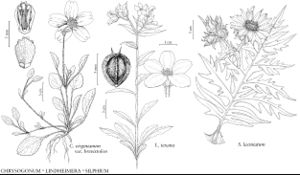Chrysogonum
Sp. Pl. 2: 920. 1753.
Gen. Pl. ed. 5, 391. 1754.
| Taxon | Illustrator ⠉ | |
|---|---|---|
 | Chrysogonum virginianum var. brevistolon Lindheimera texana Silphium laciniatum | Linny Heagy Barbara Alongi Yevonn Wilson-Ramsey |
Perennials, 2–30 (–50) cm (aerial stems from fibrous-rooted rhizomes to 5 cm). Stems erect to erect-ascending (flowering) or prostrate (vegetative stolons), branched from bases or ± throughout (villous). Leaves basal and cauline; opposite; petiolate; blades elliptic-ovate to deltate-ovate, bases cordate or truncate to cuneate, margins crenate, faces hairy. Heads radiate, borne singly or in pairs. Involucres cupulate-hemispheric, 7–10 mm diam. Phyllaries persistent (outer), 8–10 in 2 series (outer spreading, oblong-oblanceolate, foliaceous, inner erect, greenish, smaller, ± scarious). Receptacles flat to shallowly convex, paleate (paleae oblanceolate, scarious). Ray-florets 5 (–6), pistillate, fertile; corollas yellow. Disc-florets 25–50, functionally staminate; corollas yellow, tubes shorter than narrowly funnelform throats, lobes 5, deltate. Cypselae (blackish brown) strongly obflattened, obovoid to obovate (each basally adnate to 1 inner phyllary, 3 paleae, and 3 disc-florets, the “cypsela-complexes” falling as units); pappi persistent, coroniform (asymmetric). x = 16.
Distribution
e United States
Discussion
Species 1.
Each cypsela-complex includes an elaiosome (a fleshy, oil-bearing structure at the base of the phyllary) and two associated paleae. Ants carry cypsela-complexes into their underground nests, chew off the elaiosomes, and return the undamaged cypselae or complexes to the surface.
Chrysogonum virginianum has been divided into two species (e.g., J. K. Small 1933) or treated as a single species with two varieties (e.g., A. E. Radford et al. 1968; T. F. Stuessy 1977). Stuessy mapped many intermediates between two varieties, not only in the area of North Carolina and South Carolina where their ranges meet, but also practically throughout both their ranges. G. L. Nesom (2001) found three allopatric taxa, separated primarily by habit (production or not of stolons) and morphology of flowering stems. Plants treated here as C. virginianum var. australe might justifiably be treated at specific rank.
All three taxa of Chrysogonum are now used as garden plants and are sold in nurseries under horticultural names.
Selected References
Lower Taxa
"broader" is not a number.